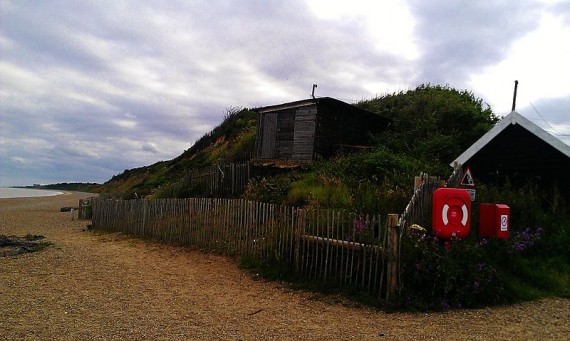All The People Are Underwater!
17. 8. 2013 // Stewart Home // Kategorie Randnotizen 2013
A few days ago I decided I wanted to revisit Dunwich, now a small village on the east coast of England but in the medieval period an international port and one of the most important cities in the country. Much of the town and its harbour were lost to coastal erosion in the thirteenth and fourteenth centuries. According to local legend, at the turning of certain tides it is possible to hear the bells of Dunwich’s eight lost churches toll from beneath the waves. There has also been speculation that the city and its fate inspired H. P. Lovecraft in his choice of location name for The Dunwich Horror – although that particularly tale is set in Massachusetts rather than on the English north sea.
I first visited Dunwich in 1984 on a day trip from London with friends. Dunwich is slightly less than 150 km north east of London, so day trips are one way to get there, although when I visited the village more frequently in the 1990s I often stayed nearby for a night or two. I love the shingle beach and really dig Dunwich Heath; which is covered in heather and gorse. Lowland coastal heath was once common where the county of Suffolk meets the North Sea, but today it is unusual since it has mostly been built over or destroyed by agriculture.
To get to Dunwich by public transport I first took a train from London Liverpool Street to Ipswich. Rather than having a national rail provider, in the UK there are many train companies. The service I joined at Liverpool Street is run by Greater Anglia, a franchise owned by Abellio (the international operation of Dutch government rail operator Nederlandse Spoorwegen). I bought an advance ticket since this was a lot cheaper than buying one at the station immediately before getting on the train. I found myself in a coach in which all the seats were reserved to Ipswich but there were hardly any passengers. I’m told there are regularly whole carriages of reserved seats with hardly anyone in them on Greater Anglia services. By this means I was accompanied by ghost travellers on my journey to the city beneath the sea.
There were only two stops before I alighted, Colchester and Manningtree. Colchester was once the capital of Roman Britain and some claim it is the oldest town in UK. More than that its rather too grand castle, it is the old houses in the Dutch Quarter that are the sights most worth seeing in Colchester – although it is a while since I last went to look at them! Manningtree is where people change to get the branch line to Harwich and then take ferry services to Denmark and Holland. In the seventeenth-century, Manningtree was the home of that notorious sadist Matthew Hopkins – the self-styled Witchfinder General – who was responsible for the ‘judicial’ murder of about 300 women between 1644 and 1646. Between Manningtee and Ipswich there is a spectacular view of the Stour Estuary from the train, and it would be worth making the journey I took for that alone.
Changing trains at Ipswich I continued my travels on a Greater Anglia branch line, this time as far as Darsham in the Suffolk Coastal District. The final 7 km to Dunwich must be undertaken by road. When I finally reached my destination there were a few people in the Dunwich Museum and a few more on the beach but the place wasn’t busy. I like to sit and listen to the sound of waves hitting shingle, even more than hearing waves breaking on a sand beach. When I walked away from the village there was no one at all about. As night fell I listened to the noise of birds and insects falling away to virtually nothing. Although I love living in the city, experiencing the silence of the countryside at night every once in a while is also a groove sensation!

Top image Dunwich Beach. Bottom image Dunwich Heath.


